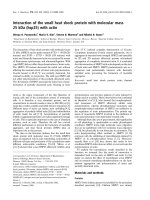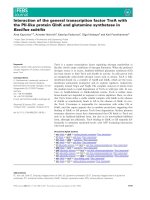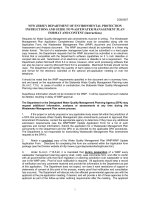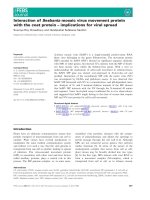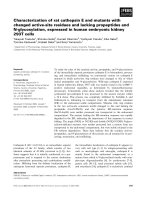Interaction of environmental calcium phosphate and ph with glass ionomer restoratives
Bạn đang xem bản rút gọn của tài liệu. Xem và tải ngay bản đầy đủ của tài liệu tại đây (5.04 MB, 207 trang )
INTERACTION OF ENVIRONMENTAL
CALCIUM/PHOSPHATE AND pH
WITH GLASS IONOMER RESTORATIVES
WANG XIAOYAN
(BDS) Beijing Medical University,
(MD) Peking University
A THESIS SUBMITTED
FOR THE DEGREE OF DOCTOR OF PHILOSOPHY
DEPARTMENT OF RESTORATIVE DENTISTRY
NATIONAL UNIVERSITY OF SINGAPORE
2006
i
Acknowledgements
I would like to thank Faculty of Dentistry, National University of Singapore and
School and Hospital of Stomatology, Peking University for giving me the opportunity
to undertake this research.
I would like to thank and express my sincere gratitude to my supervisor Dr.
Adrian Yap U Jin. I am strongly motivated by his passion and knowledge in research
work. His invaluable advice, encouragement, patience and care guided me through my
research journey in Singapore.
I am also grateful to my co-supervisors Dr. Hien Ngo from Colgate Australian
Clinical Dental Research Center, Adelaide University, Australia, Dr. Zeng Kaiyang
from Department of Mechanical Engineering, National University of Singapore, and
my thesis committee member Dr. Anil Kishen from Department of Restorative
Dentistry, National University of Singapore, for their advice, guidance and help in this
research project.
I would also like to thank Assistant Professor Chen Jiaping from Department of
Chemical & Biomolecular Engineering, Associate Professor Hsu Chin-ying, Stephen,
Senior Laboratory Officer Mr Chan Swee Heng from Faculty of Dentistry, National
ii
University of Singapore, and Senior Laboratory Officer Ms Shen Lu from Institute of
Material Research and Engineering, for their assistance in conducting the research.
Special thanks are due to colleagues of our team, Chung Sew Meng, Soh Mui
Siang and Wu Xiaowa, for their generous help and assistance.
Heartfelt thanks also go to all my friends in Singapore and China, especially my
fellow colleagues in Dentistry Research Laboratory, for their help.
I would also like to express my appreciation to Professor Gao Xuejun, current
Head of Department of Cariology, Endodontology and Operative Dentistry, School
and Hospital of Stomatology, Peking University, Professor Wang Jiade, former Head
of Department of Cariology, Endodontology and Operative Dentistry, School and
Hospital of Stomatology, Peking University, and Professor Yu Guangyan, Dean of
School and Hospital of Stomatology, Peking University, for their support and concern.
Finally, but most of all, I am deeply grateful to my family, especially my husband
Peng Xin, for their endless love, patience and understanding.
iii
Table of Contents
Foreword Acknowledgements
i
Table of Contents
iii
List of Tables and Figures
vi
Summary
xi
Notice
xiii
Chapter 1 Introduction
1
1.1 Clinical performance of glass-ionomer restoratives
1.1.1 Longevity of glass-ionomer restoratives in vivo
1.1.2 Failure of glass-ionomer restoratives in vivo
1.2 Recent studies on chemical environment and GICs in vitro
4
4
10
12
Chapter 2 Literature Review
14
2.1 Development of GICs
2.1.1 Modification of the glass
2.1.2 Modification of the polyelectrolyte
2.1.3 Inclusion of resins
2.2 Complex chemical environment in vivo
2.2.1 Biological variation
2.2.2 Diet
2.2.3 Other factors
2.3 Interaction between chemical environment and GICs
2.3.1 Saliva
2.3.2 Intra-oral pH
2.3.3 Other factors
2.4 Strategies and methods for characterizing GICs
2.4.1 Indentation testing
2.4.1.1 Micro-indentation testing
2.4.1.2 Nano-indentation testing
2.4.2 SEM/EDS
2.4.3 FTIR-ATR
2.4.4 Mechanical profiler
16
16
19
21
24
26
26
28
29
29
32
34
37
40
40
41
42
43
45
iv
Chapter 3 Research Objectives and Research Program
3.1 Aims
3.2 Research program
46
47
Chapter 4 Environmental Degradation of GICs: A Preliminary Study
4.1 Introduction
4.2 Materials and methods
4.3 Results
4.4 Discussion
4.5 Conclusions
51
53
58
64
68
Chapter 5 Influence of Environmental Calcium/Phosphate and pH on GICs
5.1 Introduction
5.2 Materials and methods
5.3 Results
5.4 Discussion
5.5 Conclusions
69
71
74
91
94
Chapter 6 Surface Characterization of GICs Exposed to Acidic Conditions:
Effects of Environmental Calcium/Phosphate
6.1 Introduction
6.2 Materials and methods
6.3 Results
6.4 Discussion
6.5 Conclusions
96
98
102
119
122
Chapter 7 Ion Release by GICs Exposed to Acidic Conditions: Effects of
Environmental Calcium/Phosphate
7.1 Introduction
7.2 Materials and methods
7.3 Results
7.4 Discussion
7.5 Conclusions
123
125
128
141
145
v
Chapter 8 Effects of Environmental Calcium/Phosphate on OCA Wear and
Shear Strength of GICs Subject to Acidic Conditions
8.1 Introduction
8.2 Materials and methods
8.3 Results
8.4 Discussion
8.5 Conclusions
146
148
151
155
161
Chapter 9 General Conclusions, Proposed Mechanism and Future
Perspectives
9.1 Results and general conclusions
9.2 Proposed mechanism of interaction between GICs and
environmental calcium/phosphate and pH
9.3 Future perspectives
162
165
168
References References for Chapter 1 to 9
171
Appendices
Appendix A Preparation of storage media of varying calcium/phosphate
and pH
190
Appendix B Preparation of TISAB II
192
vi
List of Tables and Figures
Tables
Table 1-1 Longevity of glass-ionomer restoratives
5
Table 2-1 Concentration of selected inorganic constituents of whole saliva
and plaque fluid
25
Table 2-2 The pH and selected inorganic content in different beverage and
foodstuffs
27
Table 2-3 In vitro studies on artificial saliva and GICs
30
Table 2-4 General information of the surface analytical techniques used for
GICs
38
Table 2-5 FTIR peak assignment for GICs
44
Table 4-1 Technical profiles of the materials evaluated in present study
53
Table 4-2 Hardness and elastic modulus of GICs in 100% humidity and
water
59
Table 4-3 Statistical comparison of hardness and elastic modulus between
100% humidity and water
59
Table 4-4 Hardness and elastic modulus of FL and FN in acidic media of
varying pH
62
Table 4-5 Statistical comparison of hardness and elastic modulus between
ionic media of varying pH
62
Table 5-1 Compositions of storage media
72
Table 5-2 Hardness (HV) of FN
77
Table 5-3 Elastic modulus (GPa) of FN
78
Table 5-4 Hardness (HV) of KM
79
Table 5-5 Elastic modulus (GPa) of KM
80
Table 5-6 Statistical comparison of hardness and elastic modulus (4 weeks)
between storage media
81
vii
Table 6-1 Compositions of acidic conditions
99
Table 6-2 Hardness and elastic modulus of FN and KM (at displacement of
10µm)
108
Table 6-3 Statistical comparison of hardness and elastic modulus between
acidic conditions (at displacement of 10µm)
108
Table 6-4 Surface compositions (atom%) of FN measured with EDS
114
Table 6-5 Surface compositions (atom%) of KM measured with EDS
114
Table 6-6 Mean surface roughness values (Ra) (µm) for FN and KM
119
Table 6-7 Statistical comparison of Ra (µm) between acidic conditions
119
Table 7-1 pH of storage media after 4 weeks
128
Table 7-2 Ion / ligand release by FN
132
Table 7-3 Statistical comparison of ion/ligand released by FN between
acidic storage media
132
Table 7-4 Ion / ligand release by KM
133
Table 7-5 Statistical comparison of ion/ligand released by KM between
acidic storage media
133
Table 7-6 Kinetics of fluoride release (µg·cm
-1
·day
-1
) by FN
135
Table 7-7 Kinetics of fluoride release (µg·cm
-1
·day
-1
) by KM
136
Table 7-8 Cumulative fluoride release (µg·cm
-1
) by FN
137
Table 7-9 Cumulative fluoride release (µg·cm
-1
) by KM
138
Table 7-10 Statistical comparison of fluoride release (daily) between acidic
storage media
139
Table 8-1 Cumulative wear depth (µm) of FN and KM in different acidic
conditions
153
Table 8-2 Statistical comparison of wear depth (µm) between acidic
conditions
153
Table 8-3 Shear strength (MPa) of FN and KM
154
Table 8-4 Statistical comparison of shear strength between acidic
conditions
155
viii
Figures
Figure 1-1 Continuum of direct tooth-colored restorative materials
1
Figure 2-1 Diagram of set GIC structure
15
Figure 2-2 Skeletal structure of calcium fluoroaluminosilicate glass
16
Figure 2-3 Major acids used in GICs
20
Figure 2-4 Structure of monomers tethered to polyacids
22
Figure 2-5 Structure of monomers present in hybrid cement system
23
Figure 4-1 Depth-sensing micro-indentation testing set-up
55
Figure 4-2 A typical P-h curve during a loading-unloading cycle
57
Figure 4-3 Hardness and elastic modulus of GICs in 100% humidity and
water
58
Figure 4-4 Hardness and elastic modulus of FL in ionic media of varying
pH
60
Figure 4-5 Hardness and elastic modulus of FN in ionic media of varying
pH
61
Figure 4-6 Indent impressions of various GICs in water
63
Figure 5-1 Hardness and elastic modulus of FN
75
Figure 5-2 Hardness and elastic modulus of KM
76
Figure 5-3 FN after conditioning at pH 7
83
Figure 5-4 FN after conditioning at pH 5
84
Figure 5-5 FN after conditioning at pH 3
85
Figure 5-6 FN after conditioning at pH 3 (Magnification ×1000)
86
Figure 5-7 KM after conditioning at pH 7
87
Figure 5-8 KM after conditioning at pH 5
88
Figure 5-9 KM after conditioning at pH 3
89
Figure 5-10 KM after conditioning at pH 3 (Magnification ×1000)
90
ix
Figure 6-1 Photo and schematic of MTS Nano Indenter® XP
100
Figure 6-2 FTIR instrumentation and ATR apparatus
101
Figure 6-3 Contact stiffness vs. displacement curves for FN
104
Figure 6-4 Contact stiffness vs. displacement curves for KM
105
Figure 6-5 Hardness and elastic modulus as a function of displacement for
FN
106
Figure 6-6 Hardness and elastic modulus as a function of displacement for
KM
107
Figure 6-7 FTIR spectra of FN
111
Figure 6-8 FTIR spectra of KM
112
Figure 6-9 SEM of FN
116
Figure 6-10 SEM of KM
117
Figure 6-11 Mean surface roughness values (Ra) for FN and KM
118
Figure 7-1 Ion/ligand release by FN
130
Figure 7-2 Ion/ligand release by KM
131
Figure 7-3 Kinetics of fluoride release by FN
135
Figure 7-4 Kinetics of fluoride release by KM
136
Figure 7-5 Cumulative fluoride release by FN
137
Figure 7-6 Cumulative fluoride release by KM
138
Figure 7-7 Percentage of SrHPO
4
precipitations as a function of Sr
2+
and
PO
4
3-
level
140
Figure 7-8 Percentage of CaHPO
4
precipitations as a function of Ca
2+
and
PO
4
3-
level
140
Figure 7-9 The possible molecular structures in set GICs
143
Figure 8-1 Photograph and schematic presentation of the micro-punch
apparatus
149
Figure 8-2 Photograph and schematic presentation of the wear
instrumentation
150
x
Figure 8-3 Cumulative wear (µm) of FN in different acidic conditions
152
Figure 8-4 Cumulative wear (µm) of KM in different acidic conditions
152
Figure 9-1 Shear strength of FN and KM
154
Figure 9-2 Illustration of interaction of GIC with environmental
phosphate and pH
167
xi
Summary
Glass-ionomer cements (GICs) are biocompatible, anticariogenic and can
chemically adhere to tooth structure. These positive characteristics account for their
popularity in dentistry. The clinical performance of GIC restoratives, however, varies
in different patients. Intra-oral environment of patients is complex and consists of
mechanical, biological, thermal and chemical factors. GICs, being hydrophilic and
salt-based, are susceptible to degradation by the intra-oral chemical environment.
While GICs are vulnerable to acids, some components e.g. calcium and phosphate in
the oral environment may have positive effects on GICs. Little information is
currently available on the co-effects of pH and inorganic constitutes of saliva on GICs.
This new knowledge will lead to better understanding of the clinical performance of
GICs, provide guidance to their clinical use and facilitate development of new
materials.
The effects of environmental calcium/phosphate and pH on two highly viscous
GIC (HVGIC) restoratives were investigated in this study. Results suggest that the
effects of environmental calcium and phosphate on both calcium and strontium based
HVGICs are pH dependent. When pH was at 7 and 5, variations in environmental
calcium and phosphate levels did not significantly affect the hardness, elastic modulus
and surface structure. However, at pH 3, hardness and elastic modulus of these GICs
were increased by the addition of environmental phosphate. The improved properties
xii
were strongly correlated to a modified surface reaction layer arising from the
interaction between environmental phosphate and GICs when exposed to acids (pH
3).
The structure, compositions and physico-mechanical properties of the surface
reaction layer were characterized using a series of surface analytic techniques. When
subjected to higher levels of environmental phosphate, the surface reaction layer was
thinner and mechanical properties of the surface reaction layer were higher. This layer
consisted of two distinct zones, an inner degradation zone and an outer phosphate
complexation zone. The outer zone was closely related to the presence of
environmental phosphate and may be responsible for the reduction of the inner
degradation zone. Results of ion release from GICs suggest that the phosphate uptake
in the outer zone may be the result of ligand exchange between environmental
phosphate anions and intrinsic carboxyl groups. The results of ion release also
confirmed the inhibition effect of environmental phosphate on acid degradation of
GICs.
Moreover, the clinically related properties of wear resistance and shear strength
of GICs in acidic conditions were also improved when phosphate was present.
Although fluoride released by GICs in acidic conditions was slightly decreased by
environmental phosphate, the fluoride release was kept at a substantial level. The
findings of the current study suggest that the introduction of local phosphate to GICs
may result in better clinical performance of glass-ionomer restoratives in vivo.
xiii
Notice
Sections of the results and related research in this thesis have been presented,
published, accepted for publication or are submitted.
International Journal Papers
1. Yap AUJ, Wang XY, Wu XW, Chung SM. Comparative hardness and modulus
of tooth-colored restoratives: A depth-sensing microindentation study.
Biomaterials 2004;25:2179-2185.
2. Wang XY, Yap AUJ, Ngo HC. Effect of early water exposure on strength of
glass ionomer restoratives. Operative Dentistry 2006;31:584-589.
3. Wang XY, Yap AUJ, Ngo HC, Chung SM. Environmental degradation of
glass-ionomer cements: A depth-sensing microindentation study. Journal of
Biomedical Materials Research, Part B: Applied Biomaterials (Accepted for
publication).
Conference Papers
1. Xiaoyan WANG, Adrian YAP, Vicky WU, Sew Meng CHUNG.
Comparative
hardness and modulus of direct tooth-colored restorative materials. NHG Annual
Scientific Congress, Oct 2003, Singapore.
2. Adrian YAP, Vicky Xiaowa WU, Xiaoyan WANG, Sew Meng CHUNG. Effects
of thermal fatigue on the mechanical properties of tooth-coloured restorative
materials. NHG Annual Scientific Congress, Oct 2003, Singapore.
3. X.Y. Wang, A.U.J. Yap, K.Y. Zeng. Effect of environmental calcium/phosphate
on acid resistance of glass ionomers. 19
th
IADR/SEA, Sept 2004, Thailand.
4. Xiaoyan WANG, Adrian YAP, Qihui Sam, Sihan Lee. Effect of early water
contact on shear punch strength of highly viscous glass-ionomers. 8
th
NUS-NHG
Scientific Congress, Oct 2004, Singapore.
xiv
5. Xiaoyan WANG, Adrian YAP. Effect of environmental pH on surface hardness
and indentation modulus of glass ionomers. NHG Annual Scientific Congress,
Oct 2004, Singapore.
6. Xiaoyan WANG, Adrian YAP.
Effect of aqueous environment on surface
properties of highly viscous glass-ionomers. NHG Annual Scientific Congress,
Oct 2004, Singapore.
7. X.Y. Wang, A.U.J. Yap, H.C. Ngo, K.Y. Zeng. Interaction of environmental
calcium/phosphate with glass ionomers. IADR 83
rd
general session, Mar 2005,
USA.
8. X.Y. Wang, A.U.J. Yap, H. Ngo, K.Y. Zeng, L. Yang, J.P. Chen. Surface
characterizations of glass-ionomers in acidic environments with
calcium/phosphate supplement. 20
th
IADR/SEA, Sept 2005, Malaysia.
9. Xiaoyan WANG, AUJ YAP. Effect of environmental calcium/phosphate and pH
on fluoride release from glass-ionomers. Combined Scientific Meeting, Nov
2005, Singapore.
10. Xiaoyan WANG, AUJ YAP. Influence of calcium/phosphate supplements to
acidic conditions on clinically related properties of glass-ionomers. Combined
Scientific Meeting, Nov 2005, Singapore.
Awards
X.Y. Wang, A.U.J. Yap, K.Y. Zeng. Effect of Environmental Calcium/Phosphate on
Acid Resistance of Glass Ionomers.
Awarded Best Paper in Dental Materials Laboratory Research at 19
th
Annual
Scientific Meeting, International Association for Dental Research Southeast Asian
Division, 2004, Thailand.
1
Chapter 1
Introduction
The use of tooth-colored restorative materials has increased significantly due to
rising aesthetic demands by patients. Contemporary direct tooth-colored restorative
materials include glass-ionomer cements (GICs), resin-modified glass-ionomer
cements (RMGICs), polyacid-modified resin composite (compomer), giomers and
composite resins. GICs and composite resins possessing distinctive characteristics are
on the two extreme ends of the continuum of direct tooth-colored restorative materials
(Figure1-1).
Figure 1-1 Continuum of direct tooth-colored restorative materials
GIC
RMGIC
Giomer
Compomer
Composite Resin
Acid-base reaction
Resin
Chapter 1
2
An ideal restorative material should have comparable properties to tooth tissue.
No existing materials, however, completely fulfill this criterion. GIC sets by an
acid-base reaction and has the advantages of fluoride release, chemical adhesion with
tooth structure and excellent biocompatibility. Composite resin, on the other hand, is
cured by free radical addition polymerization and has the merits of excellent
aesthetics and good handling property. Modern hybrid direct tooth-colored restorative
materials have been developed based on GIC and/or composite technique to
incorporate the advantages of both materials.
Since GICs were first reported by Wilson and Kent (1972), both polyacid liquid
and basic glass powder have been continuously modified to achieve optimum
mechanical, aesthetic and handling properties. Alterations in powder and liquid
formulation or powder to liquid ratio result in GICs with a variety of
physico-mechanical properties and clinical applications.
Based on their clinical applications, GICs can be categorized using the following
classifications (Wilson and Mclean, 1988a):
Type I Luting and bonding cement
Type II Restorative cement
(a) aesthetic
(b) reinforced
Type III Lining or base cements
Chapter 1
3
Luting and bonding GICs are composed of finer powder particles at a low
powder:liquid ratio to achieve an optimum film thickness. Lining GIC has similar
powder to liquid ratio as luting GIC, while base GIC consists of higher percentage of
glass powder for base purpose. Restorative GIC has the highest content of glass
particles compared to other types of GICs. Amongest GIC restoratives,
metal-reinforced GIC (MRGIC) has been developed by adding metals or sintering
silver with glass particles. With increased physical properties, MRGIC is, however,
lack of aesthetic properties and wear resistance. In addition, highly viscous GIC
(HVGIC) with rapid set and great physical properties has been subjected to occlusal
defects. Regarding HVGICs, excess calcium ions are removed from the surface of
glass particles and higher powder to liquid ratio is adopted (Mount, 2002). With
improved physical and handling properties, HVGICs are also named “packable” GIC.
According to their setting reactions, GICs can also be classified as conventional
GICs and resin-modified GICs (RMGICs). Conventional GIC consists of
polycarboxylic acids and basic fluoroaluminosilicate glass particles. It sets by an
acid-base reaction between the polyacids and glass particles, which is capable of fully
curing in the dark. RMGIC is composed of water-soluble resin monomers in addition
to conventional polycarboxylic acids and glass particles. This type of GIC is hardened
not only by acid-base reaction but also by free radical addition polymerization of resin
monomers. Both conventional and resin-modified GICs can be used as luting,
bonding, lining, base and restorative materials.
Chapter 1
4
1.1 Clinical performance of glass-ionomer restoratives
GICs are commonly used in deciduous teeth as alternatives to dental amalgam. In
permanent teeth, they are mainly employed in cervical lesions, atraumatic restorative
technique (ART), tunnel and sandwich techniques due to their excellent bonding and
moderate mechanical properties. In addition, GICs are also indicated in patients with
high caries risk, such as patients with xerostomia, taking advantage of the cariostatic
potential of fluoride release from glass-ionomer materials.
1.1.1 Longevity of glass-ionomer restoratives in vivo
Several clinical trials have been conducted on the longevity of GICs over the last
decade or so. Some clinical trials published in full text since 1991 are summarized in
Table 1-1. These studies longitudinally observed restorative GICs for at least 2 years.
Those studies involving non-restorative GICs or specifically recruiting subjects with
high risk of caries were excluded. It can be seen that longevity of glass-ionomer
restoratives varied widely between different clinical surveys. Like other dental
restoratives, the longevity of glass-ionomer restoratives is influenced by operator,
material and patient factors (Manhart et al., 2004).
a. Operator effect
GICs are prepared immediately before insertion in cavities and are fragile for
some time after hardening. Taifour et al. (2002) examined glass-ionomer restoratives
Chapter 1
5
Table 1-1 Longevity of glass-ionomer restoratives
Authors Observation
Period
(years)
Black
Class
Restorative Materials Sampl
e
Size
Survival
Rate
Survival criteria
Yu et al. (2004) 2 I
#
II
#
I
#
II
#
Fuji IX GP (HVGIC, GC, Japan)
Fuji IX GP (HVGIC, GC, Japan)
KetacMolar (HVGIC, ESPE, Germany)
KetacMolar (HVGIC, ESPE, Germany)
20
a
15
a
17
a
20
a
89.2%
49.1%
93.8%
55.0%
Present, good or marginal defect less than
0.5mm
Mandari et al.
(2003,2001)
6
2
I
#
Fuji II (GIC, GC, Japan) 177
b
212
b
72%
96%
Perfect or satisfied marginal adaption and
anatomic form without secdonary caries
+
Gao et al.
(2003)
2.5 I
#
Fuji IX GP (HVGIC, GC, Japan)
KetacMolar (HVGIC, ESPE, Germany)
12
b
17
b
92%
88%
Retention
Mallow et al.
(1998)
3 I
#
Fuji II (GIC, GC, Japan) 39
b
59% Present, good or marginal defect less than
0.5mm
Hubel and Mejare
(2003)
3
II* Fuji II (GIC, GC, Japan)
Vitremer (RMGIC, 3M, USA)
62
a
53
a
81%
94%
Perfect or satisfied marginal adaption and
anatomic form without secdonary caries
+
Espelid et al.
(1999)
3 II* Vitremer (RMGIC, 3M, USA)
KetacSilver (MRGIC, ESPE, Germany)
49
a
49
a
98%
73%
Perfect or satisfied marginal adaption and
anatomic form without secdonary caries
+
Qvist et al. (1997) 3
8
I/II*
KetacFil (GIC, ESPE, Germany) 515
a
63%
58%
Retention (including censored restorations)
Kilpatrick et al.
(1995)
2.5 II* KetacFil (GIC, ESPE, Germany)
KetacSilver (MRGIC, ESPE, Germany)
46
a
46
a
77%
59%
Perfect or satisfied marginal adaption and
anatomic form without secdonary caries
+
Ostlund et al.
(1992)
3 II* ChemFil (GIC, Dentsply, USA) 25
a
40% Perfect or satisfied marginal adaption and
anatomic form without secdonary caries
+
Chapter 1
6
Table 1-1 (Continued)
Authors Observation
Period
(years)
Black
Class
Restorative Materials Sample
Size
Survival
Rate
Survival criteria
Welbury et al.
(1991)
5 II* KetacFil (GIC, ESPE, Germany) 119
a
67% Perfect or satisfied marginal adaption and
anatomic form without secdonary caries
+
Franco et al. (2006) 5 V Vitremer (RMGIC, 3M, USA) 28
b
96.4% Retention
Onal and Pamir
(2005)
2 V Vitremer (RMGIC, 3M, USA) 24
a
100% Retention
Brackett et al.
(2003, 1999)
2 V Fuji II LC (RMGIC, GC, Japan)
KetacFil (GIC, ESPE, Germany)
PhotacFil (RMGIC, ESPE, Germany)
37
a
34
a
34
a
96%
93%
93%
Retention
Loguercio et al.
(2003)
5 V Vitremer (RMGIC, 3M, USA) 16
a
93% Retention
Ermis (2002) 2 V Vitremer (RMGIC, 3M, USA) 20
a
95% Retention
Folwaczny et al.
(2001)
3 V Fuji II LC (RMGIC, GC, Japan)
PhotacFil (RMGIC, ESPE, Germany)
51
a
31
a
96%
90%
Retention
Neo and Chew
(1996)
3 V KetacFil (GIC, ESPE, Germany) 50
a
96% Retention
Powell et al. (1995) 3 V KetacFil (GIC, ESPE, Germany) 37
b
97.3% Retention
#
ART restoration; *Restorations in primary teeth;
a
Number at start;
b
Number at final recall;
+
Modified USPHS Ryge criteria
GIC: Conventional GIC; RMGIC: Resin-modified GIC; HVGIC: Highly viscous conventional GIC; MRGIC: Metal-reinforced GIC
Chapter 1
7
manipulated and placed by 8 operators and found a significant difference in survival
rate of GIC restorations between different operators after 3 years. In another study on
GICs handled by general practitioners, although proper powder to liquid ratio for
preparation was indicated by manufacturers, GICs were quite often mixed in a much
lower powder to liquid ratio and may have less-than optimum physical properties
(Billington et al., 1990).
To minimize the operator effect, manufacturers introduced GIC in capsulated
form. The capsulated materials are standardized with fixed powder to liquid ratio and
mixed by shaking or rotating machines ensuring optimum properties (Nomoto et al.,
2004). Meantime, light-cured and fast-set GICs of quick initial set were also
developed. This leads to less sensitivity to early moisture contamination and therefore
optimum properties of GICs. In addition, well-informed instructions for material
usage reduce technique difference between experienced practitioners and
inexperienced ones. Application of surface coating on GICs is generally employed to
overcome early moisture sensitivity and dehydration of glass-ionomer restoratives
(Mount, 1999).
b. Material type
Physico-mechanical properties of GICs vary enormously among different types of
GICs and commercial products. This also accounts for the varied clinical performance
of glass-ionomer restoratives. Conventional GICs are auto-cured within several
minutes, while RMGICs are light-initiated and polymerized instantaneously by
Chapter 1
8
incorporation of photoinitiator. The additional water-soluble resin monomers bestow
RMGICs more aesthetic property than conventional ones (Yap et al., 1999).
Auto-cured HVGICs were developed by stripping excess calcium ions from the
surface of glass particles. HVGICs have improved mechanical properties via
modifications of glass particle size, size distribution and glass surface reactivity
(Young et al., 2004).
HVGICs were originally developed for atraumatic restorative technique (ART).
This technique is noted by removal of tooth decay with hand instruments and filling
cavity with GICs (Frencken et al., 1996). The survival rate of ART restoratives using
contemporary HVGICs is higher than early conventional GICs as shown in Table 1-1.
However, Yu et al. (2004) reported that ART using HVGICs was only suitable for
Class I lesion but not for Class II cavity.
GICs are generally not considered as routine restoratives in stress-bearing
posterior teeth due to their inadequate strength. In early clinical trials, conventional
GICs (40%) in Class II cavities of primary teeth had lower success rate compared to
amalgam (92%) (Ostlund et al., 1992). With improvement of glass-ionomer materials,
the longevity of conventional GICs in later studies was higher than before.
Additionally, RMGICs performed better than early conventional GICs in Class II
restorations and were comparable to amalgam in deciduous teeth (Table 1-1).
In case of Class V restorations, although the longevity was slightly different
between various commercial products (Brackett et al., 2003, 1999; Ermis, 2002),
Chapter 1
9
GICs generally had satisfactory performance in restoring cervical defects as shown in
Table 1-1.
c. Patient effect
Besides the operator and material factors, patient factor has a significant
influence on glass-ionomer restoratives. In a clinical survey for causes of restoration
failure, the ranking of failure factors was in decreasing order of patient, operator and
material factors (45%, 35% and 20%, respectively) (Maryniuk and Kaplan, 1986). It
is well-known that the oral environment is complex and varies among individuals.
The intra-oral mechanical, biological, thermal and chemical environments may
independently or conjunctly influence the longevity of dental restorations in vivo.
Pyk and Mejare (1999) evaluated 242 tunnel restorations of reinforced GICs for
3.5 years and found failure of restorations in molar was four times higher than
premolar. Mjör and Jokstad (1993) observed that glass-ionomer restoratives in upper
molar suffered more bulk fracture. In another study of tunnel restorations, patients
with high caries activity experienced significantly more failure of restorations (Strand
et al., 1996). When GICs were applied in xerostomic patients, all restorations
presented shorter survival time (Wood et al., 1993). Moreover, some studies reported
deterioration of cervical GIC restoratives and dissolution of GIC open-sandwich
restorations (Abadalla et al., 1997; Van Dijken, 1994; Van Dijken et al., 1999). Pluim
and Arends (1986) evaluated solubility of GICs in vivo and found some patients had a
larger material loss than others. In another study, a patient with diabetes taking
Chapter 1
10
sugarless diet had minimal degradation of GICs in vivo and very little S. mutans
counts (Mesu and Reedijk, 1983). The aforementioned studies suggest the oral
environment may play an important role in the performance of glass-ionomer
restorative in vivo.
1.1.2 Failure of glass-ionomer restoratives in vivo
In terms of in vivo evaluation of dental restoratives, the most commonly used
criterion is the United States Public Health Service (USPHS) system, also named
Ryge criteria. In most clinical trials, the restoratives are qualitatively judged by
anatomy form, marginal adaptation, color match, marginal discoloration, surface
roughness, as well as secondary caries following Ryge criteria (Ryge et al., 1981).
Clinical studies have shown that bulk fracture and loss of anatomy form are the
main reasons for the failure of GIC restoratives in general practice (Mjör, 1997;
Mandari et al., 2001, Burke et al., 2001). For xerostomic patients, the most frequently
observed failure for glass-ionomers were loss of anatomy, marginal deterioration and
erosion of material (McComb et al., 2002; Hu et al., 2002).
Glass-ionomers suffered more bulk fracture when inserted in a large Class I
cavity. Bulk fracture of Class II restoratives was mostly located at the isthmus
(Smales et al., 1990; Qvist et al., 1997). These results may be ascribed to the low
capacity of GICs to undergo strain without fracture. It also indicates that GIC is not
suitable for stress-bearing sites.
